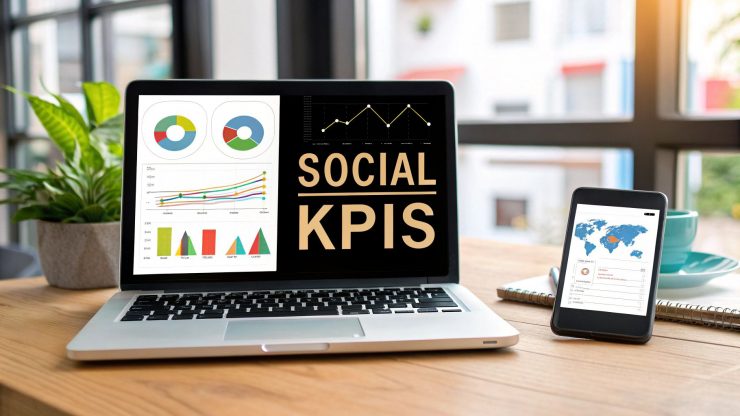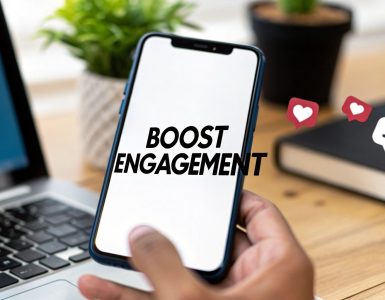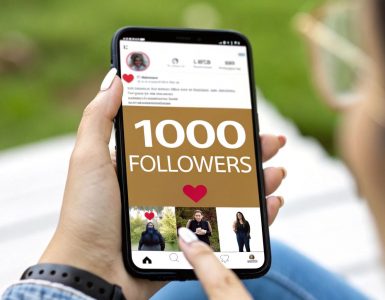Social media key performance indicators (KPIs) are the specific, measurable data points that tell you if your social media efforts are actually moving the needle for your business. It's easy to get caught up in "vanity metrics" like likes and follower counts, but true KPIs go much deeper. They act as the vital signs for your strategy, showing you what's working and what's not.
Ultimately, they give you the hard evidence needed to prove your return on investment and make smarter decisions.
Why Social Media KPIs Are Your Strategic Compass

Think about trying to sail a ship across the ocean without a compass or a map. You're definitely moving, but are you headed toward your destination or just drifting in circles? That’s exactly what running a social media strategy without KPIs feels like—plenty of activity, but no real direction or proof of progress.
These indicators are so much more than just numbers on a dashboard. They are the essential bridge connecting your day-to-day posts, comments, and campaigns to your company's bigger goals. They take a vague objective like "boost brand awareness" and turn it into something tangible, like "achieve a 15% increase in post reach this quarter."
Moving Beyond Guesswork
Without clear social media KPIs, you're essentially flying blind and relying on guesswork. It's easy to assume a post with a ton of likes was a huge success. But a KPI-focused approach forces you to ask the tougher, more important questions. Did that popular post actually drive traffic to our website? Did it generate any qualified leads? Did it contribute to sales?
This is the crucial difference between simply being busy and being effective.
Solid KPIs give you the data you need to:
- Justify Budgets: Show the C-suite the concrete value your social media efforts are delivering in a language they understand.
- Optimize Your Strategy: Pinpoint exactly which content, platforms, and campaigns resonate most with your audience so you can double down on what works.
- Prove ROI: Draw a straight line from your social media spending to actual revenue and other critical business outcomes.
By focusing on the right KPIs, you change the conversation from, "Hey, we got a lot of likes!" to "Our latest campaign generated 50 new leads at a cost of just $10 per lead." Now you're talking about real business impact.
To get started, it helps to group your metrics into a few key buckets. This framework ensures you're looking at the full picture, from initial awareness all the way to customer loyalty.
The Four Core Categories of Social Media KPIs
| KPI Category | What It Measures | Example Metrics |
|---|---|---|
| Reach & Awareness | How many people see your content and how familiar they are with your brand. | Impressions, Follower Count, Post Reach, Audience Growth Rate |
| Engagement | How audiences are interacting with your content. | Likes, Comments, Shares, Clicks, Saved Posts, Mentions |
| Conversion | How many users take a desired action because of your social media. | Website Clicks, Lead Generation, Sales Revenue, Download Rate |
| Loyalty & Advocacy | How existing customers and fans feel and talk about your brand. | Customer Reviews, Testimonials, Brand Mentions, Net Promoter Score (NPS) |
Using these categories helps you build a balanced scorecard for your social media performance, preventing you from focusing too heavily on one area while neglecting others.
KPIs in a Crowded Digital World
The need for this data-driven approach is only growing. The sheer scale of social media is staggering—the potential audience is massive and still expanding. By 2025, an estimated 5.45 billion people are expected to use social media, which is about 67.1% of everyone on the planet. If you want to dive deeper, you can find more game-changing social media statistics that show just how much these platforms have grown.
In such a jam-packed environment, just "having a presence" on social media isn't a strategy. Success demands precision. KPIs are the tools that give you that precision, guiding every piece of content you create and ensuring your efforts are always tied to a measurable goal. They turn your social media from a hopeful gamble into a predictable engine for growth.
From Awareness to Action: A Simple KPI Framework
Let's be honest, staring at a dashboard full of social media metrics can feel overwhelming. It's easy to get lost in a sea of numbers without knowing what they actually mean for your business. The best way to make sense of it all is to stop lumping every metric together and start organizing them around your customer's journey.
Think of it as building a relationship with your audience. It happens in stages, and each stage has its own goals and, more importantly, its own specific KPIs to track. This approach helps you focus on what truly matters right now. If you're launching a new product, you’ll be obsessed with the first stage. A more established brand, on the other hand, might pour its energy into the later stages to build loyalty and drive sales.
Stage 1: Awareness
This is your first handshake, your grand introduction. The main goal here is simple: get your brand in front of as many of the right people as possible. You're not asking for a sale or even a follow just yet. You're just trying to make people aware that you exist and have something interesting to offer.
At this stage, the big question you're trying to answer is: "How many people are we reaching?"
The key KPIs to watch are:
- Reach: This is the total number of unique individuals who see your content. It’s your fundamental measure of audience size.
- Impressions: This is the total number of times your content was shown to users. One person can see your post multiple times, so impressions will almost always be higher than reach.
- Audience Growth Rate: This tells you how fast you're attracting new followers. A steady increase here shows your brand's influence is expanding.
Stage 2: Engagement
Okay, so people know who you are. Now what? The next step is to get them talking. This is where you measure how people are actually interacting with your content. Are they just scrolling past, or are they stopping to like, comment, or share? Strong engagement is a clear sign that your message is hitting the mark and you're building a genuine connection.
Here, you’re asking: "Who is interacting with our content and how?"
Engagement is the crucial bridge between someone knowing you exist and them taking action. It proves your audience isn't just a passive observer but is genuinely interested in what you have to say. When you consider that 90% of consumers use social media to follow trends, you realize just how vital engagement is for staying relevant.
The image below shows how these core KPIs build on one another, starting with growing your audience, then engaging them, and finally, turning them into customers.
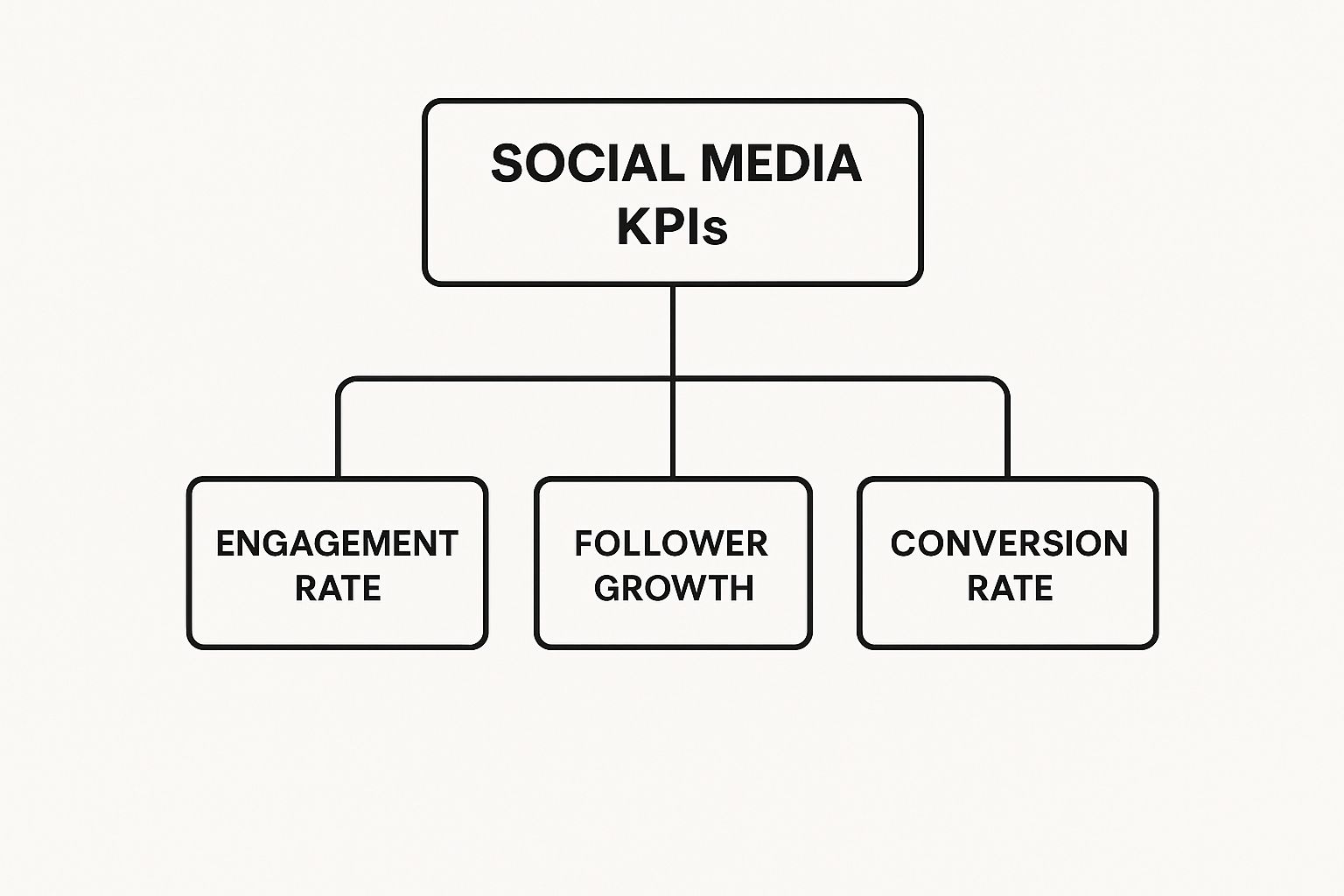
As you can see, you can't get to the top of the pyramid (conversions) without first building a solid foundation of followers and keeping them engaged.
Stage 3: Conversion
This is where the rubber meets the road. The final stage is all about turning your social media efforts into real, measurable business results. It’s about getting your followers to take that next step, whether that's signing up for a newsletter, downloading a guide, or making a purchase. These are the KPIs that directly impact your bottom line and prove your social media ROI to stakeholders.
The ultimate question becomes: "Are our efforts driving valuable actions?"
Your most important conversion KPIs are the ones tied directly to business goals:
- Click-Through Rate (CTR): What percentage of people who saw your post actually clicked the link inside it?
- Lead Conversion Rate: Of all the interactions on your social channels, how many turned into a new lead for your sales team?
- Sales Revenue: The holy grail. This is the total amount of sales generated directly from your social media activity.
By sorting your KPIs into this simple three-part framework, you can turn a chaotic jumble of data into a clear story. You can actually see how your audience moves from discovering your brand to making a final decision, giving you the power to optimize every step of the way.
Choosing KPIs That Align with Your Business Goals

A long list of social media metrics is just noise. The real magic happens when you handpick the right Key Performance Indicators—the ones that draw a straight line from your social media activity to your core business objectives. Without that connection, you’re just spinning your wheels, pouring time and money into efforts that might look busy but don't actually move the needle.
Think of it like training for a marathon. You could track dozens of health stats: your sleep quality, daily steps, hydration levels. But if your goal is to finish the race faster, your most important metrics are your mile time and endurance. The other numbers are helpful, sure, but they aren't the main event.
This is what turns your social media reporting from a messy data dump into a strategic tool for growth.
Connect Your Goals to Your Metrics
First things first: get brutally honest about what you're trying to achieve. Are you a startup desperate to get your name out there? Or an established brand focused on driving sales from your loyal followers? Your answer completely changes which numbers you should be obsessing over.
Every major business goal has a matching set of social media KPIs that tell you if you're on the right track. The key is to resist the temptation to track everything. A scattered approach leads to scattered results. A focused one drives intentional growth.
The table below is a practical roadmap, connecting common business goals with the KPIs that actually matter for each.
Matching Social Media KPIs to Business Objectives
This table is a practical guide connecting common business goals with the most relevant Key Performance Indicators to track for success.
| Business Goal | Primary KPIs to Track | Why It Matters |
|---|---|---|
| Increase Brand Awareness | • Reach • Impressions • Audience Growth Rate • Share of Voice (SOV) |
These metrics show how many people see your brand and how your presence is growing. It's the foundation of getting noticed. |
| Generate More Leads | • Click-Through Rate (CTR) • Conversion Rate • Cost Per Lead (CPL) |
This group tracks how well you move people from social media to your site and turn them into potential customers. |
| Boost Sales and Revenue | • Sales Revenue (from social) • Cost Per Acquisition (CPA) • Average Order Value (AOV) |
These are the bottom-line numbers that directly tie your social campaigns to the money they’re making for the business. |
| Improve Customer Loyalty | • Engagement Rate • Customer Satisfaction (CSAT) • Customer Lifetime Value (CLV) |
Loyalty is built through great interactions. These KPIs measure the health of your community and its long-term value. |
This alignment helps you prove the value of your work and make smarter decisions about where to invest your efforts next.
Prioritize for Maximum Impact
Once you’ve mapped your goals to KPIs, it’s time to prioritize. You simply can't focus on everything at once. Pick one or two main business goals for a specific period—say, a quarter—and build your strategy around moving those specific KPIs.
For instance, a business launching a new product should make Brand Awareness their top priority. Their dashboard would be all about Reach and Impressions. A company in a crowded market, however, might zero in on Lead Generation, making Click-Through Rate and Cost Per Lead their north star metrics. For a deeper dive on refining your approach, you can learn more about how to improve your social media marketing strategy in our dedicated guide.
The goal isn't just to measure; it's to make better decisions. A focused KPI framework tells you exactly where to put your time and budget for the greatest return.
This strategic focus is more critical than ever when you look at the money involved. Social media ad spend is expected to hit $276.7 billion in 2025. Even more telling, a recent Sprout Social media statistics report shows a massive trend: 83% of this spend is projected to come from mobile by 2030. In such a competitive space, unfocused efforts get drowned out fast.
Ultimately, by choosing your KPIs with intention, you ensure every post, every campaign, and every dollar has a clear purpose. This is what separates brands that just exist on social media from those that truly thrive because of it.
How to Actually Track and Measure Your KPIs
Okay, so you’ve picked out your KPIs. That’s a great first step, but it’s only half the job. All that data is just noise if you can't easily get your hands on it and see what it's telling you. Tracking your KPIs properly means getting past the guesswork and building a solid, repeatable process to see how you're really doing.
The best part? You don't need a huge budget to get started. In fact, the most straightforward option is probably one you already have access to: the analytics tools built right into the social platforms themselves.
Start with Native Analytics Tools
Every major social network offers its own built-in dashboard for business or creator accounts. These are fantastic, free resources for digging into your core data. Think of them as the standard instrument panel in your car—they give you all the essential info you need to get where you're going.
- Meta Business Suite: This is your hub for Facebook and Instagram. It breaks down everything from reach and engagement to audience demographics and individual post performance. You can pinpoint exactly which posts are getting people to react.
- LinkedIn Analytics: If you're in the B2B space, this is your goldmine. It serves up data on visitor demographics, content engagement, and follower trends. You can even see the job titles of the people interacting with your page.
- TikTok Analytics: This is where you’ll find the nitty-gritty on video performance—metrics like views, average watch time, and where your traffic is coming from. It’s essential for figuring out what makes users stop scrolling.
While these tools are powerful, relying on them alone means you'll be constantly jumping between different tabs and websites to piece together the full picture. That gets old, fast. This is where dedicated social media platforms can be a lifesaver.
Use Third-Party Social Media Tools
For a much more organized approach, third-party social media management tools like Sprout Social or Hootsuite are a total game-changer. These platforms pull all your analytics from every channel into one clean, unified dashboard. It’s like upgrading from that standard car dashboard to a full-on command center.
These tools can save you countless hours by automating all that manual data pulling and report building. They also often provide deeper insights that the native tools don't, like sentiment analysis or what your competitors are up to. In fact, a team's confidence in their social media ROI can be up to twice as high when using social listening tools. That confidence is crucial when you consider that users spend over 14 billion hours daily on social platforms—a massive pool of potential customers. To get a better handle on these numbers, check out the latest social media statistics from Talkwalker.
These integrated platforms are especially good at helping you prove the value of your work. When all your data is in one place, it's much easier to connect the dots between your social media activity and real business goals. Our guide explains in detail how to measure social media ROI by linking these metrics to tangible results.
Create a Simple Tracking Spreadsheet
If you're working with a tighter budget, don't sweat it. A well-organized spreadsheet is a completely legitimate and effective way to track your performance. It takes a bit more manual work, sure, but it gives you total control over how you organize and interpret your data. You can easily build a simple dashboard in Google Sheets or Excel to track your most important KPIs from one week or month to the next.
Your spreadsheet should have a few key columns:
- Date Range: The period you're measuring (e.g., "Week 1: Jan 1-7").
- Platform: The social network you're pulling data for (e.g., Instagram, LinkedIn).
- Key KPIs: A column for each metric that matters to you (e.g., Reach, Engagement Rate, Clicks).
- Top Performing Post: A link to the best post from that period.
- Notes/Insights: A spot to jot down your thoughts, like "Video content absolutely crushed it this week."
No matter which method you land on, consistency is what truly matters. Set up a regular reporting cadence—whether it's weekly or monthly—and stick to it. This turns KPI measurement from a chore into a simple routine, transforming raw numbers into your most valuable strategic asset.
Turning Raw Data into Actionable Insights
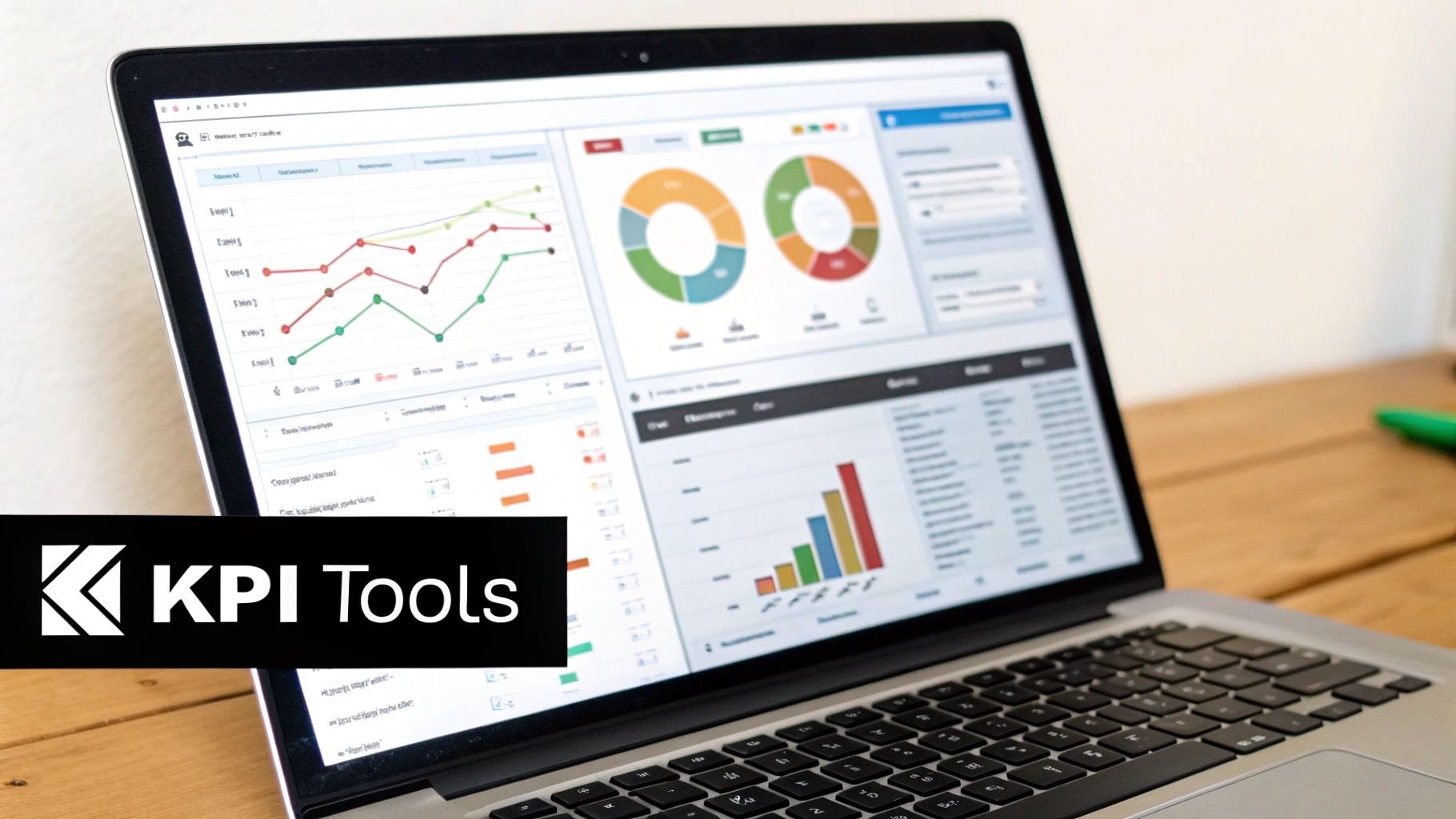
So, you’ve gathered your numbers and the spreadsheet is full. Now what? On its own, raw data is just a jumble of digits. The real magic happens when you turn those numbers into a story that guides your next move. This is the moment you stop being a data collector and become a data-driven strategist.
The first step in making sense of it all is benchmarking. Think of it this way: knowing your 100-meter dash time is one thing. But knowing how that time compares to your personal best, or to the other runners in the race? That’s what tells you if you need to pick up the pace. Benchmarking gives your data that critical context.
You can do this in two essential ways: by looking inward at your own performance and by looking outward at the competition. Both are crucial for truly understanding your social media KPIs.
Looking Inward with Internal Benchmarking
Your most important competitor is always yourself. Internal benchmarking is simply the practice of comparing your current performance to your own past results. This is often the most insightful way to measure progress because it’s tailored to your unique audience, brand, and niche.
Start by asking a few simple questions:
- How does this month's engagement rate look compared to last month's?
- Is our follower growth speeding up or slowing down this quarter?
- Did this year's holiday campaign drive more clicks than last year's?
Keeping an eye on these internal trends shows you what’s resonating with your audience. It helps you pinpoint which strategic tweaks are working and which ones aren't, allowing you to constantly refine your approach.
Looking Outward with External Benchmarking
While your own progress is key, you don't exist in a bubble. External benchmarking is all about comparing your KPIs to industry averages or even your direct competitors. This gives you a much-needed reality check on where you stand in the wider market.
A sudden drop in reach might feel like a failure. But if you check industry reports and see a major algorithm change tanked reach for everyone, that data point changes. It’s no longer a mistake on your part, but a shared hurdle the whole industry has to navigate.
Finding reliable benchmarks can take some digging, but many social media management tools and marketing research firms publish annual reports. These often break down average engagement rates, follower growth, and other key metrics by industry. Use them as a compass, not a rigid map. If your engagement is a little below the average but you’re serving a super-niche, high-value audience, you might actually be in great shape.
Asking the Right Questions to Find Trends
Once you have some context, the real detective work begins. Don't just report the numbers—interrogate them. Every spike and every dip is a clue waiting to be investigated.
For example, if a post gets a huge number of shares, dig deeper.
- What was the trigger? Did we hit on a trending topic? Was it a particular format?
- Who did the sharing? Was it our usual followers, or did a big account amplify it?
- Can we do it again? What elements from that success can we build into our future content?
The same goes for a drop in engagement. Did you change your posting schedule? Has your content gotten a bit repetitive? To get to the bottom of it, you need to understand the nuances of what drives people to act. Our complete guide to social media engagement metrics can help you unpack what's really behind those likes, shares, and comments.
Adopting this investigative mindset is what separates the pros from the amateurs. It’s how you transform a spreadsheet of data into a powerful playbook for your next campaign.
The Future of Social Media Measurement
Social media never sits still, and neither can the way we measure it. While we all keep an eye on familiar metrics like likes and reach, the real pros know that staying ahead means digging deeper than the standard dashboard. The future of social media KPIs demands a smarter approach—one that paints a richer, more complete picture of your brand's actual impact.
This shift means looking at advanced KPIs that track not just what you do, but where you stand in the larger conversations happening in your market. Getting a handle on these next-generation metrics is the key to building a strategy that doesn't just keep up, but sets the pace.
Moving Beyond Basic Metrics
To really understand your competitive position, you have to look beyond your own page and see how you stack up against everyone else. This is where advanced KPIs like Share of Voice (SOV) become so valuable. SOV cuts through the noise to tell you exactly how much of the conversation in your industry is about your brand compared to your competitors.
Another metric that's no longer a "nice-to-have" is Social Sentiment. This KPI gets to the heart of what people are saying, analyzing the emotion behind the mentions. Are people speaking positively, negatively, or just neutrally about you? A sky-high engagement rate means little if half the comments are from frustrated customers. Sentiment analysis adds that all-important context.
Think of how these two work together:
- Share of Voice: Are you leading the discussion or just listening from the sidelines? SOV reveals your visibility against the competition.
- Social Sentiment: Is your brand beloved, ignored, or actively disliked? This measures the true health of your reputation.
By tracking both SOV and sentiment, you can see not only how much people are talking about you, but also how they feel when they do. This combination offers a powerful, nuanced view of your brand's true standing in the market.
Emerging Trends Reshaping Measurement
The platforms and tools we rely on are also changing the game, forcing us to rethink what a "valuable" interaction even looks like. A few major trends are paving the way for the next chapter in social media analytics.
First up is the massive impact of AI-driven analytics. Artificial intelligence can now comb through huge amounts of data to spot complex patterns, forecast trends, and even suggest what to do next. This tech makes it possible to pull deep, actionable insights from your KPIs without spending days crunching the numbers yourself.
We’re also facing new challenges in tracking the ROI from ephemeral content. How do you truly measure the impact of an Instagram Story that vanishes in 24 hours or a TikTok that goes viral overnight? The focus is shifting from simple views to more nuanced metrics like tap-through rates, poll responses, and how much of a short-form video people actually watch.
Finally, measurement is becoming far more community-centric. With the explosion of private spaces like Facebook Groups and Discord servers, brands are learning to track engagement in these smaller, tighter-knit circles. Here, things like member activity rates and the quality of discussions are the new gold standard for a healthy, loyal community. It's a clear signal that the future is less about broadcasting to the masses and more about nurturing genuine relationships.
Answering Your Top Questions About Social Media KPIs
Diving into social media KPIs often brings up a few common questions. Let's clear up some of the most frequent points of confusion that marketers and brand owners run into.
How Often Should I Check My Social Media KPIs?
There’s no magic number here—the right timing really depends on what you're measuring and why. Think of it less as a strict schedule and more as a rhythm that matches your goals.
For the fast-paced world of engagement metrics (likes, comments, shares), a daily or weekly check-in makes sense. This helps you stay on top of conversations and engage with your community in real-time.
But for your bigger-picture KPIs like reach, follower growth, and conversion rates, looking at them monthly or quarterly is much more useful. This gives your strategy enough time to breathe and provides enough data to see real trends, preventing you from overreacting to minor daily ups and downs. Consistency is what truly matters.
What’s the Difference Between a Metric and a KPI?
It's a common mix-up, but the distinction is pretty important. The easiest way to think about it is that all KPIs are metrics, but not every metric you track is a KPI.
A metric is just a number—a single point of data, like the number of likes on your latest post. A KPI (Key Performance Indicator), on the other hand, is a metric you've hand-picked because it directly shows how you're performing against a crucial business goal.
For instance, your total follower count is a metric. But if your main goal is to build brand awareness, your follower growth rate becomes a KPI. It’s the specific metric you've flagged as key to measuring your success.
Can I Have Too Many KPIs?
Yes, you absolutely can. It’s one of the most common pitfalls out there. When you try to track everything, you often end up with "analysis paralysis"—so much data that you have no clue what actually matters or what to do next.
A dashboard crammed with dozens of metrics just creates noise. The best strategies focus on the vital few. As a rule of thumb, try to stick to 3-5 primary KPIs per business goal. This keeps you focused on the numbers that will genuinely move the needle for your business.
Which KPI Is Most Important for Proving ROI?
This is the million-dollar question, but there's no single "best" KPI that works for everyone. The most powerful KPI for proving your Return on Investment (ROI) is whichever one is closest to the money for your specific business.
Usually, this means looking at conversion-focused KPIs. Metrics like Conversion Rate from your social ads, your Cost Per Acquisition (CPA), or the Customer Lifetime Value (CLV) that comes from social media are fantastic for showing real financial impact. The trick is to pick the KPI that draws the straightest line from your social media efforts to actual revenue.
Ready to stop guessing and start growing? EvergreenFeed automates your social media scheduling, freeing you up to focus on the KPIs that matter most. Sign up for free and see how effortless an active social media presence can be.

